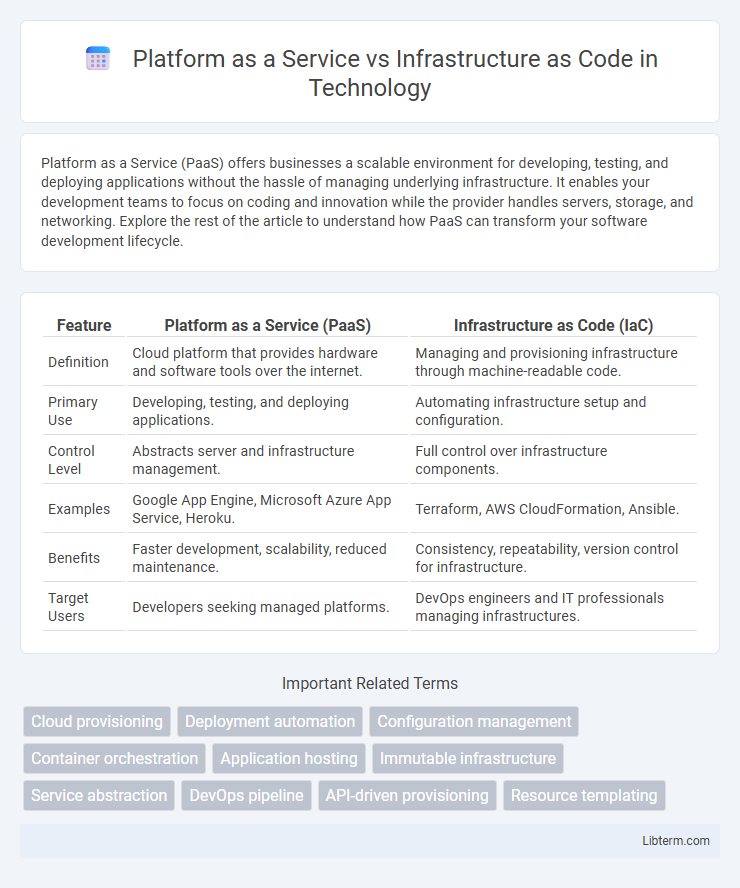Platform as a Service (PaaS) offers businesses a scalable environment for developing, testing, and deploying applications without the hassle of managing underlying infrastructure. It enables your development teams to focus on coding and innovation while the provider handles servers, storage, and networking. Explore the rest of the article to understand how PaaS can transform your software development lifecycle.
Table of Comparison
| Feature | Platform as a Service (PaaS) | Infrastructure as Code (IaC) |
|---|---|---|
| Definition | Cloud platform that provides hardware and software tools over the internet. | Managing and provisioning infrastructure through machine-readable code. |
| Primary Use | Developing, testing, and deploying applications. | Automating infrastructure setup and configuration. |
| Control Level | Abstracts server and infrastructure management. | Full control over infrastructure components. |
| Examples | Google App Engine, Microsoft Azure App Service, Heroku. | Terraform, AWS CloudFormation, Ansible. |
| Benefits | Faster development, scalability, reduced maintenance. | Consistency, repeatability, version control for infrastructure. |
| Target Users | Developers seeking managed platforms. | DevOps engineers and IT professionals managing infrastructures. |
Introduction to Platform as a Service (PaaS)
Platform as a Service (PaaS) provides a cloud computing environment that enables developers to build, deploy, and manage applications without worrying about the underlying infrastructure. PaaS platforms offer integrated development tools, middleware, and runtime environments, streamlining application lifecycle management and accelerating time-to-market. This service model contrasts with Infrastructure as Code (IaC), which focuses on automating infrastructure provisioning and management using code-based configurations.
Understanding Infrastructure as Code (IaC)
Infrastructure as Code (IaC) automates infrastructure management by using machine-readable configuration files, allowing developers to provision and maintain computing resources efficiently. Unlike Platform as a Service (PaaS), which abstracts the underlying infrastructure, IaC provides granular control over servers, networks, and storage with tools like Terraform, Ansible, and AWS CloudFormation. This approach enhances infrastructure consistency, enables version control, and accelerates deployment processes, making it essential for modern DevOps practices.
Key Differences Between PaaS and IaC
Platform as a Service (PaaS) offers a fully managed environment for application development, providing built-in infrastructure, runtime, and middleware, whereas Infrastructure as Code (IaC) enables automated provisioning and management of infrastructure through machine-readable scripts. PaaS abstracts the underlying hardware and software layers, allowing developers to focus on coding and deployment, while IaC emphasizes infrastructure automation, version control, and consistency across development, testing, and production environments. Key differences lie in PaaS delivering ready-to-use development platforms, contrasting with IaC's focus on infrastructure configuration and lifecycle management.
Core Components and Architecture of PaaS
Platform as a Service (PaaS) core components include runtime environments, middleware, development tools, and managed infrastructure designed to simplify application deployment and scalability. PaaS architecture typically features a multi-tenant environment with automated resource allocation, integrated development frameworks, and self-service portals for developers, streamlining the software development lifecycle. Unlike Infrastructure as Code (IaC), which focuses on provisioning and managing infrastructure through declarative configuration files, PaaS abstracts infrastructure management, enabling developers to concentrate on coding and application logic.
IaC Tools and Technologies Overview
Infrastructure as Code (IaC) leverages tools like Terraform, AWS CloudFormation, and Ansible to automate provisioning and management of cloud infrastructure, enabling consistent, repeatable deployments. Platform as a Service (PaaS) solutions provide managed environments such as Google App Engine and Microsoft Azure App Service that abstract infrastructure details but often limit deep customization available through IaC. The key distinction is IaC's focus on declarative configuration and infrastructure versioning using code, while PaaS emphasizes streamlined application deployment with less operational overhead.
Pros and Cons of Platform as a Service
Platform as a Service (PaaS) offers streamlined application development with built-in infrastructure management, reducing the need for manual server provisioning and enabling faster deployment cycles. It excels in scalability and automated maintenance but can lead to vendor lock-in and limited customization compared to Infrastructure as Code (IaC) solutions. However, PaaS may lack the granular control over infrastructure that IaC provides, potentially impacting complex or highly tailored environment requirements.
Advantages and Challenges of Infrastructure as Code
Infrastructure as Code (IaC) offers significant advantages like automated and consistent environment provisioning, rapid deployment, and enhanced version control for infrastructure changes, which reduce human error and improve scalability. Challenges include the complexity of managing IaC scripts, requiring specialized knowledge to write and maintain code, potential risks of misconfigurations causing widespread outages, and integration difficulties with existing systems. Compared to Platform as a Service (PaaS), IaC provides more granular control over infrastructure but demands higher technical expertise and rigorous testing to ensure reliable and secure infrastructure management.
Use Cases: When to Choose PaaS vs IaC
Platform as a Service (PaaS) is ideal for developers seeking rapid application deployment with managed infrastructure, such as web apps, mobile backends, or microservices. Infrastructure as Code (IaC) excels in automating and managing complex cloud environments, enabling consistent, repeatable provisioning for development, testing, and production workflows. Choose PaaS for streamlined development with less operational overhead, and opt for IaC when precise infrastructure control and scalability across multi-cloud or hybrid environments are required.
Security Implications: PaaS vs IaC
Platform as a Service (PaaS) abstracts infrastructure management, reducing the attack surface by delegating patching and security updates to the provider, but potentially introducing risks through misconfigured services or shared environments. Infrastructure as Code (IaC) enables automation of infrastructure deployment with version-controlled templates, improving security consistency and auditability, though it requires secure coding practices to avoid introducing vulnerabilities. Both approaches demand robust identity and access management along with regular security scanning to mitigate risks unique to their operational models.
Future Trends in Cloud Application Deployment
Platform as a Service (PaaS) emphasizes streamlined application development with managed environments, while Infrastructure as Code (IaC) enables automated infrastructure provisioning and configuration through code, enhancing repeatability and scalability. Future trends in cloud application deployment include increased integration of IaC with PaaS to support continuous delivery pipelines and multi-cloud strategies, driving faster, more resilient deployments. Emerging technologies such as AI-driven automation and policy-as-code are set to further optimize cloud infrastructure management and operational efficiency.
Platform as a Service Infographic

 libterm.com
libterm.com